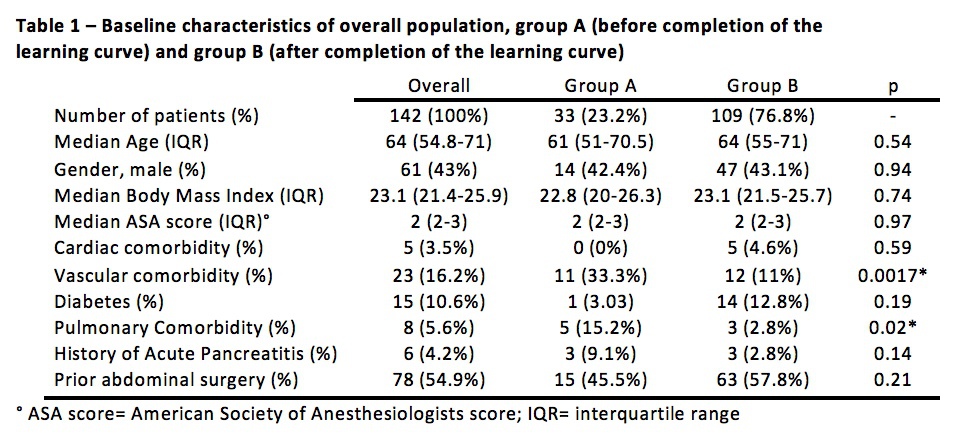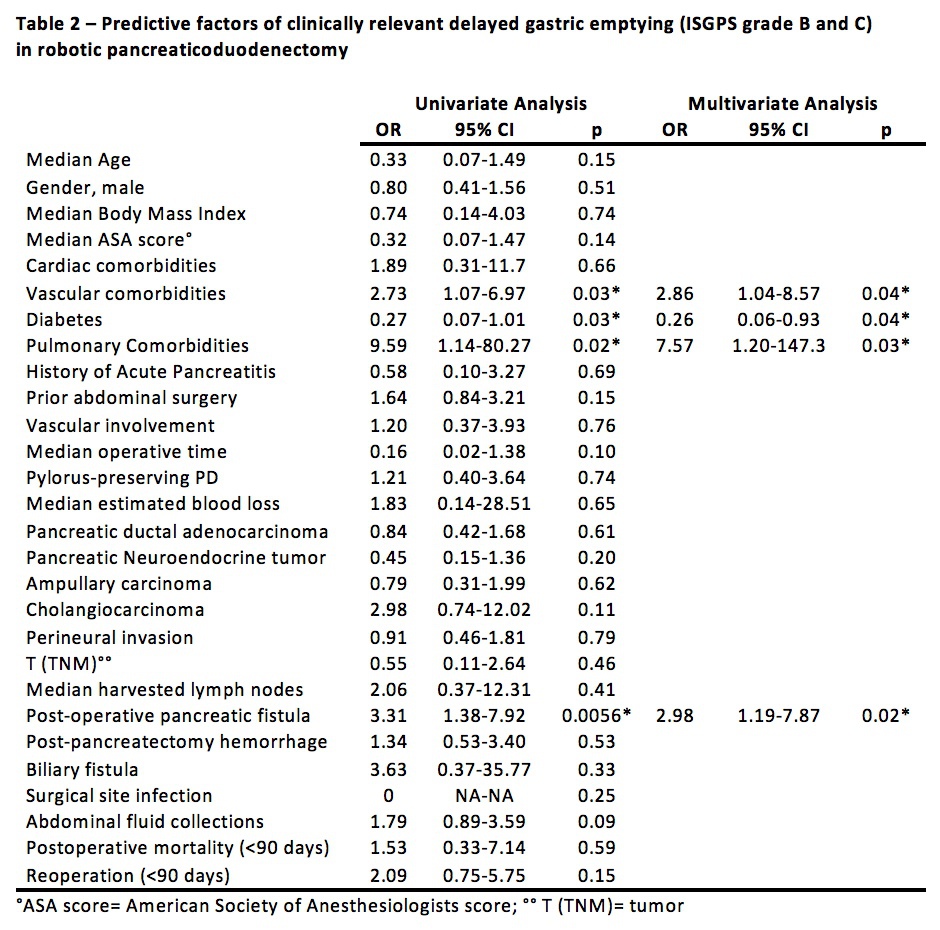
|
THE INTERNATIONAL STUDY GROUP OF PANCREATIC SURGERY GRADE B/C DELAYED GASTRIC EMPTYING IN ROBOT-ASSISTED PANCREATICODUODENECTOMY: ANALYSIS OF PREDICTIVE FACTORS AND IMPACT OF LEARNING CURVE Niccolò Napoli*, Sara Iacopi, Francesca Menonna, Emanuele F. Kauffmann, Carlo Lombardo, Ugo O. Boggi Division of General and Transplant Surgery, University of Pisa, Pisa, Italy Introduction Delayed gastric emptying (DGE) is one of the most frequent complication after pancreaticoduodenectomy (PD), but only grade B and C of the International Study Group of Pancreatic Surgery (ISGPS) classification have a significant clinical impact, prolonging hospital stay and delaying potential adjuvant therapy (Surgery, 2007). After a long gestation, laparoscopic PD is eventually gaining momentum, as it could reduce the morbidity of this formidable operation. Herein we have analyzed the risk factors and the impact of learning curve (LC) on clinically relevant DGE (crDGE) (ISGPS grades B and C) in robotic PD (RPD). Methods A prospectively maintained database of RPD performed at our institution between June 2008 and October 2017 was analyzed. In most patients the pylorus was preserved (90.1%) in combination with a Child reconstruction. DGE was classified according to the criteria of the ISGPS. Univariate and multivariate analyses were used to identify predictive factors of crDGE. Concerning the impact of LC, patients were divided into two groups: before (group A) and after (group B) the 33rd RPD needed for the achievement of the LC (Dig Surg, 2016). Linear logistic regression was used to evaluate association between crDGE and the two groups. Results One-hundred and forty-two patients were considered. Baseline characteristics of the population are reported in table 1. CrDGE occurred in 65 (45.8%) patients being of grade B in 39 (27.5%) and grade C in 26 (18.3%) of them. Patients with crDGE presented prolonged hospital stay (22 vs 15 days, p<0.0001), higher median level of Comprehensive Complication Index (29.6 vs 20.9, p<0.0001) and higher rate of major complications (Clavien-Dindo≥3) (64.3% vs 40%, p<0.036). Univariate and multivariate analyses identified the presence of vascular (p= 0.04) and pulmonary (p=0.03) comorbidities and the absence of diabetes (p=0.04) as independent preoperative predictive factors of crDGE (table 2). Postoperative pancreatic fistula (p= 0.0056) was the only postoperative predictor of crDGE (table 2). The completion of LC statistical significantly reduced crDGE rate from 72.7% to 37.6% (p=0.0004) and grade B DGE rate from 51.5% to 20.2% (p=0.0004), respectively in group A and B. Conclusion Since we established the safety and feasibility of the RPD (BJS, 2013), we focused on the elements that could reduce postoperative complications and length of stay. DGE is probably the most uncomfortable complication and its effects on the timing of hospitalization and adjuvant chemotherapy are known. Using a multivariate analysis, herein we identified three comorbidities (pulmonary and vascular comorbidities and diabetes) that seems to impact on the appearance of DGE. From these datas not only we can confirm that RPD are feasible, but also that the achievement of the LC is an important factor against this complication. 
Back to 2018 Posters |
|||||||||||||||
© 2026 Society for Surgery of the Alimentary Tract. All Rights Reserved. Read the Privacy Policy.
